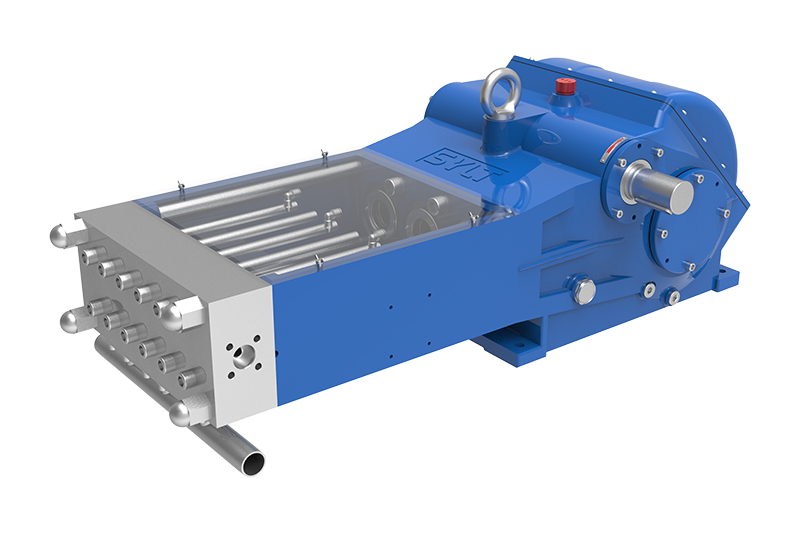The pump head (also known as the pump body or pump chamber) of a high-pressure plunger pump is a critical component that withstands high pressure, high-speed fluid impact, and friction. The material selection directly affects the pump's lifespan, efficiency, and reliability. The following is a detailed analysis of the materials used for high-pressure plunger pump heads:
1. Main Failure Modes of Pump Heads
- Corrosion: Chemical media in the fluid (such as acids, alkalis, and salts) may cause material corrosion.
- Wear: Particles in the high-speed fluid or long-term friction cause surface wear.
- Fatigue Cracking: Periodic high-pressure impact leads to material fatigue failure.
- High-Temperature Softening: Material strength decreases under high-temperature conditions.
2. Commonly Used Pump Head Materials and Their Characteristics
(1) Stainless Steel Series
- Martensitic Stainless Steel (such as 1Cr13, 2Cr13, 17-4PH)
- Advantages: High strength, moderate corrosion resistance, suitable for clean water or mildly corrosive media.
- Applications: Ordinary high-pressure water pumps, hydraulic pumps.
- Austenitic Stainless Steel (such as 304, 316L)
- Advantages: Strong corrosion resistance (especially in Cl? environments), but lower strength.
- Disadvantages: Requires surface hardening (such as nitriding) to improve wear resistance.
- Applications: Chemical industry, seawater desalination, etc., where corrosive media are present.
- Duplex Stainless Steel (such as 2205, 2507)
- Advantages: Combines high strength and high corrosion resistance, excellent resistance to stress corrosion cracking.
- Applications: Oil and gas fields, high-pressure seawater pumps.
(2) Alloy Steel
- Low Alloy Steel (such as 42CrMo, 35CrMo)
- Advantages: High strength, good toughness, surface hardness can be improved through heat treatment (quenching and tempering, carburizing).
- Disadvantages: Poor corrosion resistance, requires surface plating or coating protection.
- Applications: High-pressure oil pumps, engineering machinery pumps.
- Tool Steel (such as H13, D2)
- Advantages: High hardness and wear resistance, suitable for high-wear conditions.
- Disadvantages: High processing cost, general corrosion resistance.
(3) Nickel-Based Alloys (such as Inconel 625, Hastelloy C276)
- Advantages: High temperature resistance, corrosion resistance (strong acids, strong alkalis), excellent fatigue resistance.
- Disadvantages: Extremely high cost.
- Applications: Extreme conditions (such as petrochemicals, nuclear industry).
(4) Ceramics or Ceramic Coatings
- Zirconia (ZrO?), Silicon Carbide (SiC)
- Advantages: Ultra-high hardness, wear and corrosion resistance, suitable for high-purity or high-particle content media.
- Disadvantages: High brittleness, poor impact resistance.
- Applications: Semiconductor industry, high-precision metering pumps.
3. Key Factors in Material Selection
1. Media Characteristics: Corrosiveness, particle content, temperature, pH value.
2. Pressure Level: High pressure (>50MPa) requires high-strength materials (such as alloy steel or duplex stainless steel).
3. Wear Resistance Requirements: Particulate media require surface hardening or ceramic coatings.
4. Cost Control: Ordinary conditions can choose stainless steel or low alloy steel, extreme conditions require nickel-based alloys.
5. Processing Technology: Complex pump head structures need to consider the machinability of the material (such as casting, welding performance).
4. Surface Treatment Technology
To improve the service life of the pump head, surface treatment is often performed on the base material:
- Nitriding/Carburizing: Improves surface hardness and wear resistance.
- Spray Coating: Such as tungsten carbide (WC), diamond-like carbon (DLC) coatings.
- Electroplating: Hard chromium plating is used for corrosion protection and friction reduction.
5. Industry Application Cases
- Petroleum Industry: Duplex stainless steel (hydrogen sulfide corrosion resistance) + tungsten carbide coating.
- Chemical Industry: Hastelloy (strong acid resistance) + polytetrafluoroethylene lining.
- Water Treatment: 316L stainless steel or ceramic coating.
- Ultra-high pressure pumps (>100MPa): High-strength alloy steel (such as 30CrNiMo) or Inconel 625.
6. Future Trends
- Composite Materials: Carbon fiber reinforced polymer (CFRP) or metal matrix composite (MMC).
- Additive Manufacturing: 3D printing customized pump head structures to optimize material distribution.
- Intelligent Monitoring: Real-time monitoring of material fatigue status through embedded sensors.
Summary
The material of the high-pressure plunger pump head needs to be comprehensively selected according to the specific working conditions. Common options include stainless steel substrate + surface hardening treatment or alloy steel + anti-corrosion coating. For extreme working conditions, nickel-based alloys and ceramics are preferred, but the cost needs to be weighed. It is recommended to combine fluid simulation and actual tests to verify material performance.
The 17th China International Powder Metallurgy and Hard Alloy Exhibition
The 2025 17th China International Powder Metallurgy and Hard Alloy Exhibition from March 10-12, 2025, at the Shanghai World Expo Exhibition and Convention Center, Hall H1, B425. We welcome guests to visit.
"Private custom" product design, reliable and durable finished products
"Private custom" like product design, reliable and durable finished products, professional and timely after-sales service. It is the "three basic concepts" that the company adheres to from the beginning until today ".
Experienced market research team, independent product development concept
We have experienced mature market research team, independent product research and development concept, professional design and manufacturing technology so that the company's products can be adjusted according to the specific requirements of customers timely design







